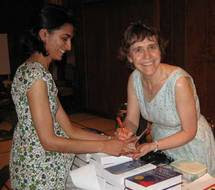View an animation showing the growth of English here.
This animation uses data from the Oxford English Dictionary (OED) to show how English has developed by borrowing or adapting words from different languages and regions of the world, from 1150 to the present day. These patterns of word-borrowing reflect the changing demography of the English-speaking world; cultural and economic influences on Britain; the spread of explorers, traders, and settlers; and encounters with other cultures.
Each data point shown here represents the first recorded use of a word in English, positioned according to the language from which the word was borrowed. The size of the data point indicates the frequency of the word: larger bubbles for higher-frequency words, smaller bubbles for lower-frequency words. You can pause the animation and hover over bubbles for more information about each word.
The progress bar at the bottom tracks the growth of English, subdivided into the major language groups from which words are derived. This reflects not only the number of recorded words in the language, but also how important those words are (how frequent they are in modern English). This shows how English has remained overwhelmingly dominated by the major language families of western Europe – Germanic, Romance, and Latin. The 7700 words derived from Germanic languages (the blue component of the progress bar) account for 49% of all English usage today. By contrast, the small yellow component at the end of the progress bar represents all borrowings from languages outside Europe: this includes about 5200 words recorded in the Oxford English Dictionary, but accounts for only about 0.2% of all English usage today.
It’s striking to see how much of modern English was already established by 1150. Although the language at this stage contained relatively few words that have survived into modern English, these include most of the core words that we use all the time (the, run, head, etc.). So the summed frequencies of these words is very high, which is why at 1150 the progress bar is already over half-way to its modern total.
P.S.
If you find the English language fascinating, you might enjoy regular
updates about English usage and word origins from Wordlady. Receive
every new post delivered right to your inbox! You can either:
use
the subscribe window at the top of this page
OR
(if
you are reading this on a mobile device): send me an email with the
subject line SUBSCRIBE at wordlady.barber@gmail.com
Privacy
policy: we will not sell, rent, or give your name or address to
anyone. You can unsubscribe at any point.
Follow
me on twitter: @thewordlady

No comments:
Post a Comment